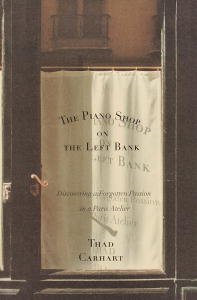What do you think?
Rate this book


304 pages, Kindle Edition
First published January 1, 2000

Benjamin Franklin had apparently spent some time within the (former) convent's walls, writing out the preamble to the American Constitution. During the (French) Revolution, the convent was turned into a prison & subsequently used as a cotton mill, then a preparatory school for the "Ecole Polytechnique", until in 1896 it began its vocation as a private school for music, dance & theater. Satie, Debussy, Albeniz & Messiaen had all been associated with the latter school and its philosophy was consciously informal & forward-looking.The author catalogues a litany of pianos, including some still eminent brands such as Bechstein (German), Bosendoerfer (Austrian) & Chickering (British) but also the all but forgotten Pleyel (French) & an extraordinary, newly crafted Italian piano, the Fazioli, seemingly made with space-age technology but very traditional values.
I particularly liked the rationale it advanced for renouncing the tradition of competitive "concours: On ne fait pas de musique contre quelqu'un" (One does not make music against someone else").

In playing, the old man was changed utterly, transformed from a stooped body with a hesitant gait to a vigorous athlete who addressed the keyboard with a boundless urgency. He was not sitting at the piano but was indivisible from it, his hands & feet striking the keys & pedals with a potent, sinuous force. The piano, too, was transformed. No delicate lines now, no strange decorum about the silent object: this was what it was meant to do.
 I don't play an instrument & so some of the minute detailing of various vintage & contemporary keyboard instruments was a bit beyond my grasp but I savored this book nonetheless and recommend it highly to anyone willing to provide it with some space in their imagination. In an odd sort of way, The Piano Shop on the Left Bank by Thad Carhart is rather like a mystery story set in Paris, with the elusive search for pianos with captivating backgrounds serving as primary characters.
I don't play an instrument & so some of the minute detailing of various vintage & contemporary keyboard instruments was a bit beyond my grasp but I savored this book nonetheless and recommend it highly to anyone willing to provide it with some space in their imagination. In an odd sort of way, The Piano Shop on the Left Bank by Thad Carhart is rather like a mystery story set in Paris, with the elusive search for pianos with captivating backgrounds serving as primary characters.